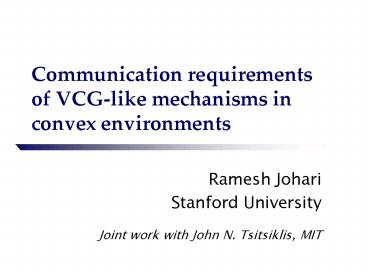Communication requirements of VCG-like mechanisms in convex environments - PowerPoint PPT Presentation
1 / 23
Title:
Communication requirements of VCG-like mechanisms in convex environments
Description:
Communication requirements of VCG-like mechanisms in convex environments Ramesh Johari Stanford University Joint work with John N. Tsitsiklis, MIT – PowerPoint PPT presentation
Number of Views:143
Avg rating:3.0/5.0
Title: Communication requirements of VCG-like mechanisms in convex environments
1
Communication requirements of VCG-like mechanisms
in convex environments
- Ramesh Johari
- Stanford University
- Joint work with John N. Tsitsiklis, MIT
2
Motivation
- Resource allocation mechanismswith scalar
strategy spaces - -single price eff. loss 25
- (J Tsitsiklis)
- -price differentiation no eff. loss
- (Yang Hajek, Maheswaran Basar)
- This talk generalization ofthe price
differentiation case
3
Outline
- Resource allocation model
- VCG mechanisms
- Scalar strategy VCG mechanisms
- Multicommodity flow models
- Extensions and related work
4
I Resource allocation model
- N users
- J resources
- Feasible allocations
- X x 2 RN x 0,
- gj(x) 0, j 1, , J
- gj() convex, differentiable
- Assume Slater condition holds
5
I Utilities and payoffs
- User r utility Ur(xr) from allocation xr
- concave, strictly increasing, differentiable
- Payment to user r tr
- User rs payoff (in )
- Pr(xr, tr) Ur(xr) tr
- ) Efficient allocation
6
II Achieving efficiency
- In general utilities are unknown
- Design payments tr to alignefficiency and
incentives - Planner wants to maximize
- User r wants to maximize
7
II VCG mechanisms
- Strategy of user rdeclared utility Vr
- Mechanism chooses x(V) s.t.
- Payment to user r
8
II VCG mechanisms
- Strategy of user rdeclared utility Vr
- Mechanism chooses x(V) s.t.
- Payment to user r
9
II VCG mechanisms
- Strategy of user rdeclared utility Vr
- Mechanism chooses x(V) s.t.
- User r chooses Vr to maximize
10
II VCG mechanisms
- Moraltruthful declaration is adominant
strategy - Problem
- Strategy spaces are overly complex
- Main insight (for Nash implementation)
- Suffices to elicit only local derivativeof
utility function
11
III SSVCG mechanisms
- VCG-like with scalar strategy spaces.
- Parameterized family U(x ?) s.t.
- x ? U(x ?) is strictly concave
- and strictly increasing, continuous,
differentiable - Slope matching
- 8 ? gt 0 and x 0,
- 9 ? gt 0 s.t. U(x ?) ?
12
III SSVCG mechanisms
- Mechanism chooses x(?) s.t.
- Payment to user r
13
III SSVCG Key lemma
- ? is a Nash equilibriumif and only if for all
r - Proof idea If x is optimal, user r can choose
?r s.t. Ur(xr) U(xr ?r)
14
III SSVCG Key lemma
- ? is a Nash equilibriumif and only if for all
r - Proof idea If x is optimal, user r can choose
?r s.t. Ur(xr) U(xr ?r)
tr
15
III SSVCG Efficient NE
- Corollary
- Efficient Nash equilibrium exists
- Proof idea Given efficient x,each user r
chooses ?r s.t. - Ur(xr) U(xr ?r)
- ) Local truthful declaration
16
III SSVCG Efficient NE
- But all NE are not efficient!
- Example
- Single resource of capacity C 1
- User 1 bids huge U(C ?1)
- All other users
- Best response is to give up
- ) User 1 gets everything, regardless of true
utilities
17
III SSVCG Efficient NE
- Given NE ?
- Define P s xs(?) gt 0
- J j gj(x(?)) 0
- d(r) ( ?gj/?xr, j 2 J )
- TheoremIf for all r, d(r) is linearly dependent
on d(s), s ? r, s 2 P,then x(?) is efficient
18
III SSVCG Efficient NE
- We know
- x(?) maxx 2 X ?r U(xr ?r)
- For all r
- x(?) 2 max x 2 X Ur(xr) ?s ? r U(xs ?s)
- First order conditions
- linear dependence assumption )
- Ur(xr(?)) U(xr(?) ?r)
19
IV Networks
- J links
- Capacity of link j Cj
- User r subset of links
- X x 0 ?r j 2 r xr Cj, for all j
- Assume For all j, two users r1(j), r2(j), s.t.
- Uri (j)(0) 1 and r1(j) r2(j) j
- Then all NE allocations are efficient
20
V Extensions
- If Ur depends on k-dimensional xr
- Need k-dimensional ?r
- Designing hr(?-r) is similar to VCG
- Budget balance, etc.
21
V Related work
- Yang Hajek (2004),Maheswaran Basar (2004)
- Single resource, capacity 1
- User r chooses bid ?r
- Allocation xr(?) ?r / ?s ?s
- User r pays tr(?) -?r ?(?s ?s)
- Same as
- SSVCG where U(x ?) -? ?(?/x)
22
V Related work
- Reichelstein and Reiter (1988)
- more general environments
- not quasilinear,no aggregated goods
- mechanism is asymmetric one user treated
differently than others - requires (J - 1) J/(N(N-1)) dimensional
strategy space per user
23
V Related work
- Semret (1999)
- Groves and Ledyard (1979)
- Yang and Hajek (2005)
- independent discovery of similar result































